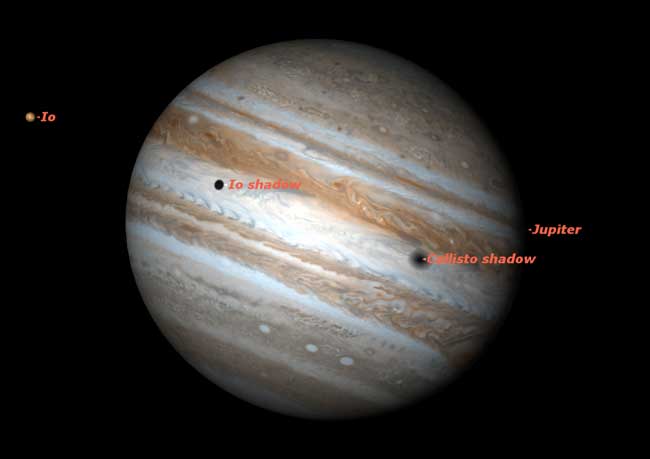
An unusual celestial vanishing act will take place the night of Sept. 2 when all four of Jupiter's largest moons will be hidden from our view.
The event will occur on a night when Jupiter happens to be positioned very close to Earth's moon in the southeastern sky. The two objects, though very far apart in space, will be about 5 degrees from each other in our sky (your fist on an outstretched arm covers about 10 degrees of sky). This pairing makes Jupiter, which outshines all stars and so is easy to spot, even easier for anyone to locate.
Anyone who points a small telescope at Jupiter will nearly always see some or all of the four well-known Galilean satellites. Usually at least two or three of these moons, and sometimes all four, are immediately evident as small star-like points of light.
It is very rare when only one moon is in view and rarer still when no moons at all are visible. When all are gone, it is because:
1) they are passing across the disk of Jupiter (in transit)
2) they are behind Jupiter (in occultation), or
3) they are within Jupiter's shadow (in eclipse).
The first-ever recorded observation of Jupiter "without a visible satellite" was apparently made in 1681. Writing about this lone episode in his 1844 book, "A Cycle of Celestial Objects," William Henry Smyth commented that this was "a conjunction which will require more than three thousand billions of years to occur again."
Smyth's estimate was a gross exaggeration. While such "moonless" occasions are rare, there are actually a dozen or more per century.
Get the Space.com Newsletter
Breaking space news, the latest updates on rocket launches, skywatching events and more!
Gian Vincenzo "Enzo" Mora of Sequals, Italy made the first extensive calculation of Jupiter's moonless occurrences in 1909. His listing, obviously intended to be exhaustive, spanned the entire 19th and 20th centuries. The studies of Mora were meticulous and no doubt required a tremendous amount of time, and all without the aid of modern computers. Modern studies, using computer technology, have demonstrated that Mora's computations were amazingly accurate, although he did overlook three occasions (in 1859, 1895 and 1962) when Jupiter appeared without satellites.
A new set of predictions has recently been drawn up by the Belgian calculator Jean Meeus for the period from 1900 to 2100 AD. According to his calculations, on the night of September 2-3, viewers across North America will have the opportunity to see all four moons out of sight for almost two hours.
Jupiter is very bright right now and easy to spot with the naked eye, at magnitude –2.0 (on this scale smaller numbers represent brighter objects, and negative numbers are the brightest). The gas giant planet will be in the eastern sky, in Capricornus, well up for most locations when the "moonless interval" begins at 12:43 a.m. EDT on Sept. 3 (for the Central, Mountain and Pacific Time Zones, it's the previous calendar day, for example: 9:43 p.m. PDT on Sept. 2).
Here's where the four Galilean moons will be at that moment:
- Io will be occulted by Jupiter's disk and then will move into Jupiter's shadow to undergo an eclipse, with no sunlight falling on it to reflect to our telescopes.
- Europa and Ganymede will both be in transit across Jupiter's disk, and so they'll be impossible to see in small telescopes amid the overwhelming sunlight reflected by Jupiter. Seasoned observers with large telescopes might spot the moon's shadows that fall on the Jovian cloud tops.
- Callisto will be in eclipse.
Ganymede will be the last to disappear at 12:43 a.m. ET. Then, at 2:29 a.m. EDT, Io will reappear into view as it emerges from Jupiter's shadow.
Joe Rao serves as an instructor and guest lecturer at New York's Hayden Planetarium. He writes about astronomy for The New York Times and other publications, and he is also an on-camera meteorologist for News 12 Westchester, New York.
Join our Space Forums to keep talking space on the latest missions, night sky and more! And if you have a news tip, correction or comment, let us know at: community@space.com.

Joe Rao is Space.com's skywatching columnist, as well as a veteran meteorologist and eclipse chaser who also serves as an instructor and guest lecturer at New York's Hayden Planetarium. He writes about astronomy for Natural History magazine, Sky & Telescope and other publications. Joe is an 8-time Emmy-nominated meteorologist who served the Putnam Valley region of New York for over 21 years. You can find him on Twitter and YouTube tracking lunar and solar eclipses, meteor showers and more. To find out Joe's latest project, visit him on Twitter.









